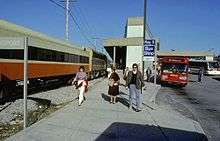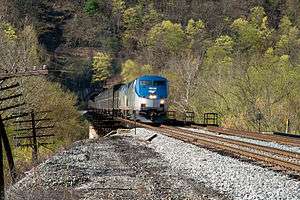Capitol Limited (Amtrak train)
|
The Capitol Limited emerges from the Graham Tunnel and crosses the Potomac River in Magnolia, West Virginia. | ||||||||||||||||||||||||||||||||||||||||||||||||||||||||||||||||||||||||||||||||||||||||||||||||||||||||||||||||||||||||||||||||||||||||||||||||||||||||||||||||||||||||||||||||||||||||||||||||||||||||||||||||||||||||||||||||||||||||||||||||||
| Overview | ||||||||||||||||||||||||||||||||||||||||||||||||||||||||||||||||||||||||||||||||||||||||||||||||||||||||||||||||||||||||||||||||||||||||||||||||||||||||||||||||||||||||||||||||||||||||||||||||||||||||||||||||||||||||||||||||||||||||||||||||||
|---|---|---|---|---|---|---|---|---|---|---|---|---|---|---|---|---|---|---|---|---|---|---|---|---|---|---|---|---|---|---|---|---|---|---|---|---|---|---|---|---|---|---|---|---|---|---|---|---|---|---|---|---|---|---|---|---|---|---|---|---|---|---|---|---|---|---|---|---|---|---|---|---|---|---|---|---|---|---|---|---|---|---|---|---|---|---|---|---|---|---|---|---|---|---|---|---|---|---|---|---|---|---|---|---|---|---|---|---|---|---|---|---|---|---|---|---|---|---|---|---|---|---|---|---|---|---|---|---|---|---|---|---|---|---|---|---|---|---|---|---|---|---|---|---|---|---|---|---|---|---|---|---|---|---|---|---|---|---|---|---|---|---|---|---|---|---|---|---|---|---|---|---|---|---|---|---|---|---|---|---|---|---|---|---|---|---|---|---|---|---|---|---|---|---|---|---|---|---|---|---|---|---|---|---|---|---|---|---|---|---|---|---|---|---|---|---|---|---|---|---|---|---|---|---|---|---|---|---|---|---|---|---|---|---|---|---|---|---|---|---|---|---|
| Service type | Inter-city rail | |||||||||||||||||||||||||||||||||||||||||||||||||||||||||||||||||||||||||||||||||||||||||||||||||||||||||||||||||||||||||||||||||||||||||||||||||||||||||||||||||||||||||||||||||||||||||||||||||||||||||||||||||||||||||||||||||||||||||||||||||
| Status | Operating | |||||||||||||||||||||||||||||||||||||||||||||||||||||||||||||||||||||||||||||||||||||||||||||||||||||||||||||||||||||||||||||||||||||||||||||||||||||||||||||||||||||||||||||||||||||||||||||||||||||||||||||||||||||||||||||||||||||||||||||||||
| Locale | Eastern United States | |||||||||||||||||||||||||||||||||||||||||||||||||||||||||||||||||||||||||||||||||||||||||||||||||||||||||||||||||||||||||||||||||||||||||||||||||||||||||||||||||||||||||||||||||||||||||||||||||||||||||||||||||||||||||||||||||||||||||||||||||
| First service | October 1, 1981 | |||||||||||||||||||||||||||||||||||||||||||||||||||||||||||||||||||||||||||||||||||||||||||||||||||||||||||||||||||||||||||||||||||||||||||||||||||||||||||||||||||||||||||||||||||||||||||||||||||||||||||||||||||||||||||||||||||||||||||||||||
| Current operator(s) | Amtrak | |||||||||||||||||||||||||||||||||||||||||||||||||||||||||||||||||||||||||||||||||||||||||||||||||||||||||||||||||||||||||||||||||||||||||||||||||||||||||||||||||||||||||||||||||||||||||||||||||||||||||||||||||||||||||||||||||||||||||||||||||
| Ridership |
621 daily 226,597 total (FY11)[1] | |||||||||||||||||||||||||||||||||||||||||||||||||||||||||||||||||||||||||||||||||||||||||||||||||||||||||||||||||||||||||||||||||||||||||||||||||||||||||||||||||||||||||||||||||||||||||||||||||||||||||||||||||||||||||||||||||||||||||||||||||
| Route | ||||||||||||||||||||||||||||||||||||||||||||||||||||||||||||||||||||||||||||||||||||||||||||||||||||||||||||||||||||||||||||||||||||||||||||||||||||||||||||||||||||||||||||||||||||||||||||||||||||||||||||||||||||||||||||||||||||||||||||||||||
| Start | Washington, D.C. | |||||||||||||||||||||||||||||||||||||||||||||||||||||||||||||||||||||||||||||||||||||||||||||||||||||||||||||||||||||||||||||||||||||||||||||||||||||||||||||||||||||||||||||||||||||||||||||||||||||||||||||||||||||||||||||||||||||||||||||||||
| Stops | 14 | |||||||||||||||||||||||||||||||||||||||||||||||||||||||||||||||||||||||||||||||||||||||||||||||||||||||||||||||||||||||||||||||||||||||||||||||||||||||||||||||||||||||||||||||||||||||||||||||||||||||||||||||||||||||||||||||||||||||||||||||||
| End | Chicago, Illinois | |||||||||||||||||||||||||||||||||||||||||||||||||||||||||||||||||||||||||||||||||||||||||||||||||||||||||||||||||||||||||||||||||||||||||||||||||||||||||||||||||||||||||||||||||||||||||||||||||||||||||||||||||||||||||||||||||||||||||||||||||
| Distance travelled | 780 mi (1,260 km) | |||||||||||||||||||||||||||||||||||||||||||||||||||||||||||||||||||||||||||||||||||||||||||||||||||||||||||||||||||||||||||||||||||||||||||||||||||||||||||||||||||||||||||||||||||||||||||||||||||||||||||||||||||||||||||||||||||||||||||||||||
| Average journey time | 18 hours | |||||||||||||||||||||||||||||||||||||||||||||||||||||||||||||||||||||||||||||||||||||||||||||||||||||||||||||||||||||||||||||||||||||||||||||||||||||||||||||||||||||||||||||||||||||||||||||||||||||||||||||||||||||||||||||||||||||||||||||||||
| Service frequency | Daily | |||||||||||||||||||||||||||||||||||||||||||||||||||||||||||||||||||||||||||||||||||||||||||||||||||||||||||||||||||||||||||||||||||||||||||||||||||||||||||||||||||||||||||||||||||||||||||||||||||||||||||||||||||||||||||||||||||||||||||||||||
| Train number(s) |
29 (Washington, D.C.–Chicago), 30 (Chicago–Washington, D.C.) | |||||||||||||||||||||||||||||||||||||||||||||||||||||||||||||||||||||||||||||||||||||||||||||||||||||||||||||||||||||||||||||||||||||||||||||||||||||||||||||||||||||||||||||||||||||||||||||||||||||||||||||||||||||||||||||||||||||||||||||||||
| On-board services | ||||||||||||||||||||||||||||||||||||||||||||||||||||||||||||||||||||||||||||||||||||||||||||||||||||||||||||||||||||||||||||||||||||||||||||||||||||||||||||||||||||||||||||||||||||||||||||||||||||||||||||||||||||||||||||||||||||||||||||||||||
| Class(es) | Coach and First | |||||||||||||||||||||||||||||||||||||||||||||||||||||||||||||||||||||||||||||||||||||||||||||||||||||||||||||||||||||||||||||||||||||||||||||||||||||||||||||||||||||||||||||||||||||||||||||||||||||||||||||||||||||||||||||||||||||||||||||||||
| Seating arrangements | Airline-style coach seating | |||||||||||||||||||||||||||||||||||||||||||||||||||||||||||||||||||||||||||||||||||||||||||||||||||||||||||||||||||||||||||||||||||||||||||||||||||||||||||||||||||||||||||||||||||||||||||||||||||||||||||||||||||||||||||||||||||||||||||||||||
| Sleeping arrangements |
Superliner Roomette (2 beds) Family Bedroom (4 beds) Superliner Bedroom (2 beds) Superliner Bedroom Suite (4 beds) Superliner Accessible Bedroom (2 beds) | |||||||||||||||||||||||||||||||||||||||||||||||||||||||||||||||||||||||||||||||||||||||||||||||||||||||||||||||||||||||||||||||||||||||||||||||||||||||||||||||||||||||||||||||||||||||||||||||||||||||||||||||||||||||||||||||||||||||||||||||||
| Catering facilities | Dining car with full china service[2] | |||||||||||||||||||||||||||||||||||||||||||||||||||||||||||||||||||||||||||||||||||||||||||||||||||||||||||||||||||||||||||||||||||||||||||||||||||||||||||||||||||||||||||||||||||||||||||||||||||||||||||||||||||||||||||||||||||||||||||||||||
| Observation facilities | Sightseer Lounge Car | |||||||||||||||||||||||||||||||||||||||||||||||||||||||||||||||||||||||||||||||||||||||||||||||||||||||||||||||||||||||||||||||||||||||||||||||||||||||||||||||||||||||||||||||||||||||||||||||||||||||||||||||||||||||||||||||||||||||||||||||||
| Baggage facilities |
Checked baggage available at selected stations | |||||||||||||||||||||||||||||||||||||||||||||||||||||||||||||||||||||||||||||||||||||||||||||||||||||||||||||||||||||||||||||||||||||||||||||||||||||||||||||||||||||||||||||||||||||||||||||||||||||||||||||||||||||||||||||||||||||||||||||||||
| Technical | ||||||||||||||||||||||||||||||||||||||||||||||||||||||||||||||||||||||||||||||||||||||||||||||||||||||||||||||||||||||||||||||||||||||||||||||||||||||||||||||||||||||||||||||||||||||||||||||||||||||||||||||||||||||||||||||||||||||||||||||||||
| Track gauge | 1,435 mm (4 ft 8 1⁄2 in) | |||||||||||||||||||||||||||||||||||||||||||||||||||||||||||||||||||||||||||||||||||||||||||||||||||||||||||||||||||||||||||||||||||||||||||||||||||||||||||||||||||||||||||||||||||||||||||||||||||||||||||||||||||||||||||||||||||||||||||||||||
| Track owner(s) | CSX and NS | |||||||||||||||||||||||||||||||||||||||||||||||||||||||||||||||||||||||||||||||||||||||||||||||||||||||||||||||||||||||||||||||||||||||||||||||||||||||||||||||||||||||||||||||||||||||||||||||||||||||||||||||||||||||||||||||||||||||||||||||||
| ||||||||||||||||||||||||||||||||||||||||||||||||||||||||||||||||||||||||||||||||||||||||||||||||||||||||||||||||||||||||||||||||||||||||||||||||||||||||||||||||||||||||||||||||||||||||||||||||||||||||||||||||||||||||||||||||||||||||||||||||||
The Capitol Limited is one of two Amtrak trains connecting Washington, D.C., to Chicago, running 764 miles (1,230 km) via Pittsburgh and Cleveland (the other is the Cardinal via Cincinnati and Indianapolis). Service began in 1981 and was named after the Baltimore and Ohio Railroad's Capitol Limited which ended in 1971 upon the formation of Amtrak. It carries the Amtrak train numbers 29 and 30, which were previously assigned to the discontinued National Limited.
During fiscal year 2011, the Capitol Limited carried over 225,000 passengers, a 3.5% increase over FY2010. The train had a total revenue of $20,312,544 in FY2011, a 9.3% increase from FY2010.[1]
History


On October 1, 1981, Amtrak inaugurated its Capitol Limited upon the discontinuance of the Shenendoah. It ran over the same route as the B&O's train east of Pittsburgh, but west of Pittsburgh it ran combined with the Chicago-New York Broadway Limited over the former Pennsylvania Railroad's Pittsburgh, Fort Wayne and Chicago Railway. Its numbers, 440 (eastbound) and 441 (westbound), were derived from the Broadway Limited's 40 and 41 and the new train also used Heritage Fleet equipment.[3] The new train replaced the Broadway Limited's former Washington section which had diverged at Philadelphia, Pennsylvania.[4]
In late 1984, the Capitol Limited re-equipped with new Amfleet II coaches but also lost its full diner east of Pittsburgh. Beginning with the October 26, 1986, timetable, Amtrak split up the Capitol Limited and Broadway Limited. The former received new numbers, 29 and 30 (which formerly belonged to the defunct National Limited), and a later schedule. The Capitol Limited continued to operate over the same route. With the change the Capitol Limited regained a full diner east of Pittsburgh, which it had lost in 1984.[5]:146
On November 12, 1990, trains were rerouted west of Alliance, Ohio, due to Conrail's desire to abandon part of the former PFW&C in northwestern Indiana; the Capitol Limited now uses the former Pennsylvania Railroad Cleveland and Pittsburgh (C&P) line north from Alliance through Hudson, Ohio, to Cleveland route. The Broadway Limited and its successor, the Three Rivers, were re-routed over the B&O's Chicago-Pittsburgh route.[5]:146–147 In October 1994, Amtrak, with great fanfare, relaunched the Capitol Limited with a new bilevel Superliner II consist.[6][7]
On February 16, 1996, an eastbound rush-hour MARC commuter train headed to Washington Union Station collided with the westbound Capitol Limited near Georgetown Junction on a snow-covered stretch of track just west of Silver Spring, Maryland. Eleven people died aboard the MARC train in the accident. Three died of injuries suffered in the impact; the rest were killed by smoke and flames. The MARC engineer and two conductors were among the dead.[8]
In November 2014, Amtrak, in the face of extreme delays, filed a complaint with the Surface Transportation Board, against CSX and Norfolk Southern, due to the frequency of extreme delays caused by freight train interference.[9]
Through cars
Between 1984 and 1986 and again from 1991 to 1993, the Capitol Limited exchanged a Chicago-Miami coach with the New York-Miami Silver Star at Washington, D.C.
During 1997 and part of 1998, Amtrak operated the Capitol Limited in conjunction with the Southwest Chief, a daily Los Angeles–Chicago service. The two trains used the same Superliner equipment sets, and passengers traveling on both trains could remain aboard during the layover in Chicago. Originally announced in 1996, Amtrak planned to call this through service the "National Chief" with its own numbers (15/16), although the name and numbers were never used. Amtrak dropped the practice with the May 1998 timetable.[10][11][12]
This route was mentioned amongst five others in the July 2010 issue of Trains magazine as slated for performance improvement,[13] and as part of its federally mandated analysis of the worst-performing long-distance routes, Amtrak determined that reinstating a through-car connection with the Pennsylvanian would result in the highest gain in monetary and customer service measurements of possible options.[14] To implement this, Amtrak plans to operate a Viewliner sleeper car, an Amfleet cafe car and two Amfleet coaches between Chicago and New York via the Capitol Limited and Pennsylvanian beginning sometime in 2011.[14] Trains magazine picked up on this in their January 2011 issue, citing that a switch would be re-installed to give the thru-cars access to parallel track. Also cited was the consist switch that would take place (shuffling sleeper and coach positions so that the transition sleeper was in the rear), an eight-hour layover on Sundays due to the Pennsylvanian's 1:20p departure (since eliminated), and the lack of Viewliner sleepers to accommodate the service (also cited are that the new ones would not roll out until 2012 at the very earliest).[15]
Former stops

The Capitol Limited's original routing west of Pittsburgh included stops in Canton, Ohio, Crestline, Ohio, Lima, Ohio, Fort Wayne, Indiana, Valparaiso, Indiana, and Gary, Indiana. Amtrak dropped Gary as a station stop on April 28, 1985. On April 27, 1986, Amtrak added Warsaw, Indiana, located between Valparaiso and Fort Wayne. All these cities lost service when Amtrak re-routed the Capitol Limited north through Toledo on November 11, 1990.[16] For a year, a dedicated bus connection was offered between Fort Wayne and Waterloo, Indiana.
Between March 2, 1982, and April 7, 1991, the Capitol Limited stopped in McKeesport, Pennsylvania, located in the Monongahela Valley southeast of Pittsburgh. At the time the Port Authority of Allegheny County operated the "PATrain" commuter rail between McKeesport and downtown Pittsburgh. The Port Authority ended the service in 1989, citing low ridership. Amtrak followed suit a year later, noting that on average one passenger boarded at McKeesport per trip during the train's final months of service at that station.[17][18] Station platform track was subsequently removed with the facility becoming an all-bus terminal.
Route details

Between Washington and Pittsburgh, it mostly follows the historic B&O route along narrow river valleys hemmed in by steep slopes, including the upper Potomac, Youghiogheny, and Monongahela Rivers. Rail trails parallel much of this route, often on the opposite banks. The route straightens and levels out from Ohio onward.[19]
The Capitol Limited operates over the following Amtrak, CSX Transportation and Norfolk Southern Railway trackage:
- Amtrak Washington Terminal, part of the Northeast Corridor
- CSX Metropolitan Subdivision, Cumberland Subdivision, Cumberland Terminal Subdivision, Keystone Subdivision, Pittsburgh Subdivision, and P&W Subdivision, Washington to Pittsburgh
- NS Pittsburgh Line and Fort Wayne Line, Pittsburgh to Alliance
- NS Cleveland Line, Alliance to Cleveland
- NS Chicago Line, Cleveland to Chicago
- Amtrak Chicago Union Station
Equipment
| June 28, 2009 | |
|---|---|
| Location | Toledo, Ohio |
| Train | Eastbound #30 |
| |
In a March 2010 document Amtrak defined a standard consist for the Capitol Limited as a baggage car, transition dormitory, two sleeping cars, a dining car, a Sightseer Lounge, a baggage-coach, and two coaches.[21]
In the fall of 2014, with delays due to freight train interference resulting in equipment shortages, Amtrak modified the consist, in order to create a fourth train set, which included two sleeping cars, two coaches, and a combined diner-lounge, and the removal of the baggage car, sightseer lounge car, a sleeping car, and a transition dormitory.[22] Complaints, however, resulted in Amtrak reverting to their standard consist.[23] In early 2015, Amtrak temporarily reverted to their five-car consist, due to the dining car and sightseer lounge going in for maintenance.
References
- 1 2 "Amtrak Ridership Rolls Up Best-Ever Records" (PDF). Amtrak. 13 October 2011. Retrieved 7 February 2012.
- ↑ Amtrak (November 7, 2011). "Amtrak System Timetable". Retrieved 2011-12-13.
- ↑ Amtrak (October 25, 1981). "National Train Timetables". Retrieved 2010-05-22.
- ↑ Sanders, Craig (2009). Canton Area Railroads. Arcadia.; 109.
- 1 2 Welsh, Joe (2006). Pennsylvania Railroad's Broadway Limited. Saint Paul, MN: Voyageur Press. ISBN 9780760323021. OCLC 65425926.
- ↑ Amtrak (October 30, 1994). "National Timetable". Retrieved 2010-05-23.
- ↑ Patch, David (October 26, 1994). "Superliner introduces travel to Chicago-Toledo-Washington". Toledo Blade. Retrieved 2010-05-23.
- ↑ "Collision in Silver Spring MARC-Amtrak tragedy". The Baltimore Sun. February 20, 1996. Retrieved April 24, 2012.
- ↑ Vantuono, William (November 17, 2014). "Amtrak files complaint with STB over Capitol Limited performance". Retrieved March 4, 2015.
- ↑ "Amtrak National Timetable". November 10, 1996. Retrieved 2010-03-14.
- ↑ "Amtrak National Timetable". May 11, 1997. Retrieved 2010-03-14.
- ↑ "Amtrak National Timetable". May 17, 1998. Retrieved 2010-03-14.
- ↑ "Amtrak Trains Under the Microscope in 2010", Trains, July 2010, 20.
- 1 2 "PRIIA Section 210 FY10 Performance Improvement Plan Capitol Limited". Trains Magazine. Amtrak. Retrieved 13 November 2010.
- ↑ "Amtrak's Improvement Wish List", Trains, January 2011, 20-21.
- ↑ Harvey, Hank (November 11, 1990). "'Train Town USA' loses rail service after 146 years". Toledo Blade. Retrieved 2010-05-23.
- ↑ Bowman, Lee (March 1, 1982). "Amtrak D.C. Train Stops In McKeesport". Pittsburgh Press. Retrieved 2010-05-23.
- ↑ Butler, Ann (February 20, 1991). "Amtrak to end McKeesport stop on Capitol Limited". Pittsburgh Press. Retrieved 2010-05-23.
- ↑ Amtrak. "Capitol Limited Route Guide" (PDF). Retrieved 2011-11-24.
- ↑ "Amtrak - Capitol Limited". Retrieved November 24, 2013.
- ↑ Amtrak (March 4, 2010). "Request for Qualifications for National Onboard Wi-Fi Installation Project". Retrieved May 26, 2011.
- ↑ "Capitol Limited Down to 5 Cars, 1 Locomotive". Akron Railroad Club. Retrieved March 4, 2014. Check date values in:
|date=(help) - ↑ "Capitol Limited Gains Another Sleeper". Akron Railroad Club. November 5, 2014. Retrieved March 4, 2015.
External links
| Wikimedia Commons has media related to Capitol Limited. |
